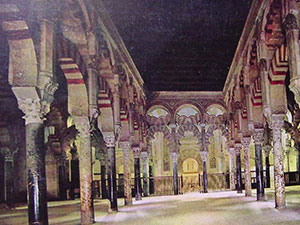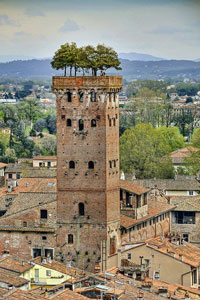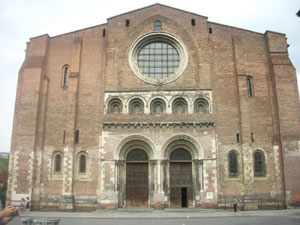
St. Mark’s Cathedral in Venice, Italy (about 1100 AD)
The Seljuks destabilize Europe’s neighbors
In 1071 AD, the Byzantine Empire lost most of Anatolia (modern Turkey) to the Seljuk Turks at the Battle of Manzikert. About the same time, the Abbasids lost control of pieces of the Islamic Empire as well.
Who were the Seljuks?
Byzantium’s Comneni Dynasty
The Early Middle Ages
High Middle Ages world timeline
All our medieval Europe articles

Cordoba mosque, Spain
The Seljuks took over the East, and local rulers took over North Africa and Spain. The breakup of these two ancient and strong empires forced European rulers to become more independent. At the same time, this made Europe stronger.
The Fatimids in North Africa
Fatimid architecture
The Umayyads in Spain

Medieval town of Lucca, Italy
Europe’s south is rich from trade
In the 1000s and into the 1100s, most of the wealth and power in Europe was in the south. Spain, southern France, Italy, and Greece were rich. Olive oil and wheat grew better in the south. Many more people lived in the south. And from the Mediterranean ports traders could sell European wool and furs and enslaved people on the Silk Road.
History of wool
Where does steel come from?
History of paper
History of slavery
Sugar and the Islamic Empire
Medicine in medieval Europe
They imported valuable steel, paper, sugar, cotton, medicine, spices, and silk to sell.The great buildings of the Romanesque period are mostly in the south, where people could afford to build them: Cordoba, Toulouse, Pisa, Florence, Venice.
Romanesque architecture
The mosque in Cordoba

Nave of Abbaye aux Dames (Caen, 1050 AD)
Wealth and power move to northern Europe
But slowly wealth and power moved to northern Europe, to England, northern France, Germany, Poland, and Hungary. Starting in the 800s, Christians of Spain moved from north to south, pushing out the Islamic rulers. Then in 962 AD, Otto the Great began to rebuild the Holy Roman Empire, centered on Germany. In 1066, William the Conqueror expanded his kingdom to begin building an empire across England and France. Matilda of Canossa ruled all of northern Italy, rich from Mediterranean trade.
Otto the Great
William the Conqueror
Matilda of Canossa
Reconquista in Spain
Ten years later, the First Crusade succeeded in taking Jerusalem from the Fatimids. Soon the Normans also controlled a lot of Italy, Sicily, and Greece. Kingdoms were also forming further east in Poland, Hungary, and Russia. Meanwhile, after Matilda died, Italy fell increasingly under the control of the Holy Roman Empire, though some city-states formed independent republics
The First Crusade
Medieval Poland
Magyars and Hungary
Medieval Russia
Republic of Florence
Climate change and cathedrals

Church of St. Sernin, Toulouse, France
This process only accelerated in the 1100s. Saladin’s Ayyubid Empire pushed more and more Mediterranean trade. Now the kings of France got control of Aquitaine and Toulouse and waged the Albigensian Crusade. Possibly climate change made it easier to grow food in northern Europe. So northern Europeans got stronger, bigger, and more numerous than southerners.
Saladin and the Ayyubids
Albigensian Crusade
Capetian rulers of France
Henry II and Eleanor of Aquitaine
The Second Crusade
The Third Crusade
Gothic cathedrals
Northern Europe grew rich enough to build the great Gothic cathedrals – which are mostly in the north. Jewish money-lenders helped to finance an expanding economy, and Jewish doctors translated the Islamic medical books of Ibn Sina and al Razi. By the early 1200s, the High Middle Ages were already giving way to the Late Middle Ages, as Europeans began to produce more manufactured things to sell, instead of selling raw materials.

Façade of Pisa’s Duomo
Learn by doing: build a castle
More about the Late Middle Ages
Bibliography and further reading about medieval history:
The Holy Roman Empire and Charlemagne in World History, by Jeff Sypeck (1997). An exciting and accurate account of the formation of one of Europe’s great empires.
Beyond the Myth: The Story of Joan of Arc , by Polly Brooks (1999). Accurate and thoughtful, with good illustrations and maps, though more a biography than a history.
Constantinople: The Forgotten Empire, by Isaac Asimov (1967). This book got many future Byzantinists started on their path. It’s out of print, but you can get it used.
A Little History of the World, by E. H. Gombrich (2003). Written in 1935, the history is a little out of date, of course, but it is written to convey the facts of all of human history to young people, and I think it does a good job.